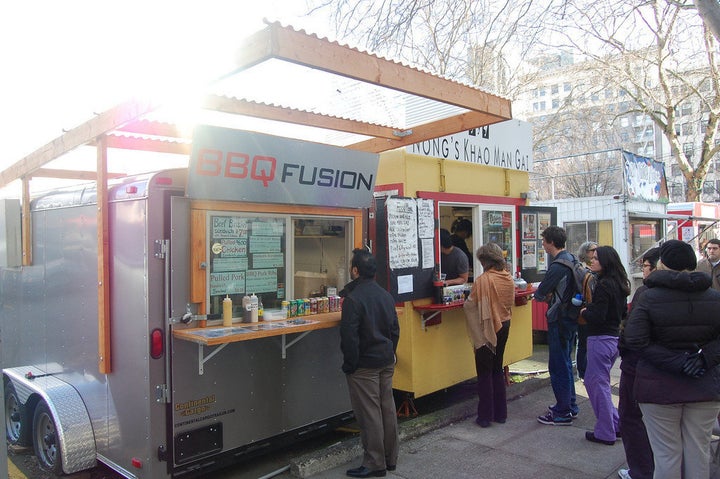
For several years, Washington, D.C. government officials have weighed how best to regulate the city's wildly popular food trucks. Proposed regulations now before the D.C. Council have earned widespread public support.
One frequent argument repeated by the few vocal opponents of food trucks is that the District should herd the trucks into a limited number of designated parking spaces. These critics claim food trucks occupy parking spaces that others might use, and that mobile vendors foster sidewalk congestion. These assertions don't withstand scrutiny. Additionally, they set up the false choice of a zero-sum game where some must win for others to lose. Smart regulations (and smart regulators) ensure that everyone subject to the rules has the opportunity to compete and win.
How can the District regulate smartly when it comes to food trucks and parking?
First, the District can dismiss arguments about the purported negative impact of food trucks on public parking spaces. If there is a parking shortage in the District, food trucks are not to blame. There are approximately eighty food trucks currently operating in the District and more than 17,000 available public parking spaces here.
Treating food trucks differently than other users of public parking is discriminatory and unfair. Brick-and-mortar restaurants use public parking spaces both to make deliveries (e.g., a pizza delivery) and receive deliveries (e.g., a delivery of food supplies). Limiting these deliveries to only designated delivery zones would pose an existential and patently unfair threat to many brick-and-mortar restaurants.
Another claim -- that food trucks "steal" parking spaces from brick-and-mortar restaurant customers --is a logical fallacy. Consider that if one brick-and-mortar restaurant customer parks in a metered parking space, then that person also extinguishes the ability of others who might have frequented a different brick-and-mortar restaurant or a food truck to park in that same space.
Appeals to public safety are similarly without merit. In a Washington Post op-ed published last month, the head of the regional restaurant association urged the District to restrict where food trucks can park because those "parked near the entrance to a building" might pose a fire hazard. But the Restaurant Association of Metro Washington (RAMW) leader fails to mention that brick-and-mortar restaurant fires -- including one at Hook Restaurant in Georgetown last summer that spread to neighboring restaurants--are not uncommon.
"Fire bad," the old Unfrozen Caveman Lawyer sketch character from Saturday Night Live might say in response. "But restaurants and food trucks good."
It turns out that food trucks may actually provide a net parking benefit to the District. A food truck parked at a meter provides double value by paying the required meter fee and contributing (through customer sales taxes) to the District's coffers. Food trucks may also help reduce parking congestion by bringing food to the people, which helps reduce overall parking demand.
On the issue of public space and sidewalk congestion, the few critics of food trucks again err. The downtown Washington, D.C. area has undergone a renaissance of sorts over the past twenty years. I first came to the District as an undergraduate at American University -- where I began my studies in 1990 and where I later earned a law degree. Back in the early- to mid-1990s, the District desperately needed to expand its tax base to help revive the city's (mis)fortunes. New brick-and-mortar restaurants like Jaleo helped turn the tide in the District's favor.
In a 2004 article, the RAMW head noted how brick-and-mortar restaurants had helped revitalize the District. And she correctly warned against those who might seek to halt this progress by pushing for stricter restaurant regulations, calling instead for "business friendly legislation to the benefit of all." She also applauded what she saw as "a trend toward a more healthy lifestyle with less driving[,] increased use of public transportation and more emphasis on neighborhood sociability emulating a town square type environment[.]"
As anyone who has lunched in Farragut Square and other public spaces in the District knows, the vibrant sidewalks and public squares we now see in many parts of the District are precisely the environment that District food trucks (and busy brick-and-mortar competitors whose clientele often spills out onto the street, including Chop't and Breadline) have helped foster.
There are many things District legislators and regulators can and should do to make it easier for brick-and-mortar restaurants here to succeed. Lowering the sales tax paid by brick-and-mortar restaurants to a level more on par with that paid in Virginia and Maryland is one such step.
But squeezing food trucks into designated parking spaces would limit choice and stifle entrepreneurship -- which drives everything from jobs to culinary trends -- while providing the public with no benefits whatsoever. If that happens, brick-and-mortar restaurants and food trucks would both lose. And the District's dining scene -- and its taxpayers -- would be left smarting.
Baylen J. Linnekin is executive director of the DC-based grassroots nonprofit Keep Food Legal, which advocates in favor of food freedom.